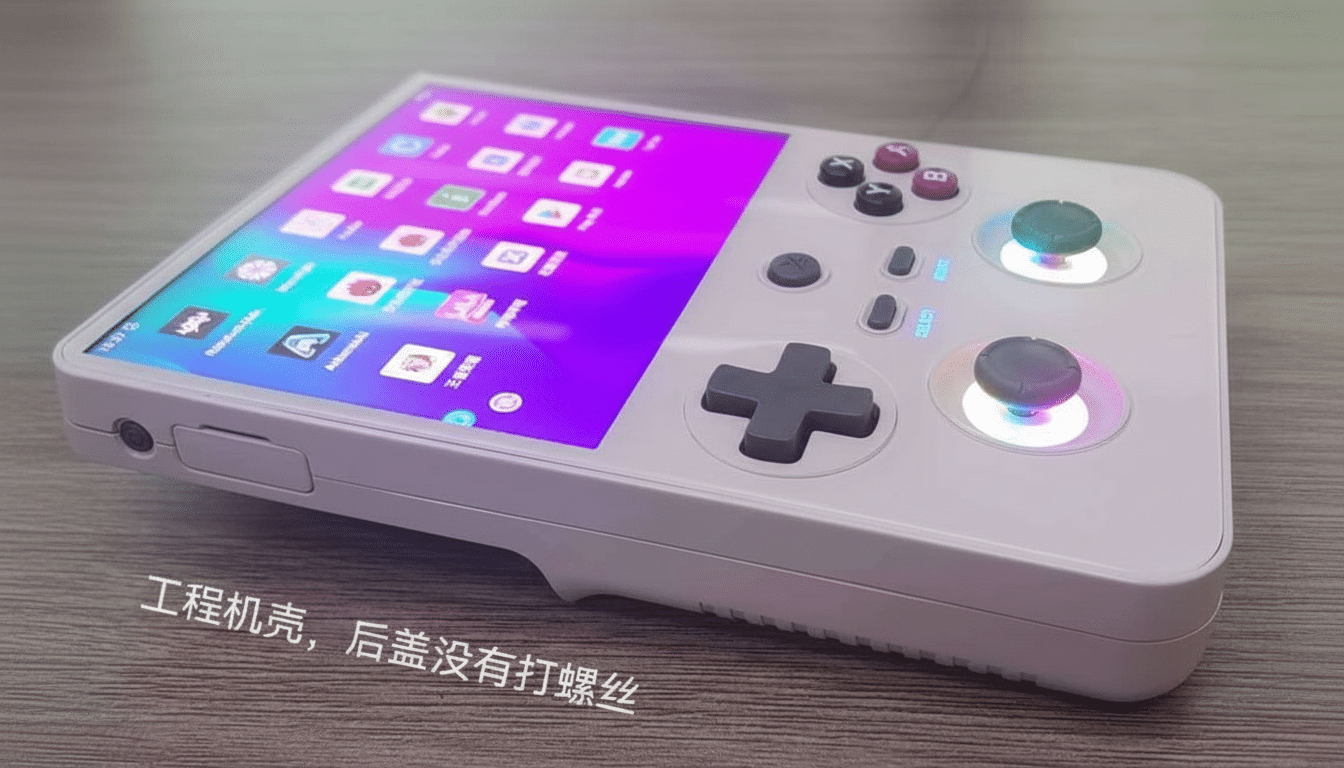Anbernic is reportedly set to launch its biggest Game Boy clone yet, the vertically oriented RG 477V with a 4.7-inch screen and MediaTek’s Dimensity 8300 SoC juking it out under the bonnet. Community sources point to an official announcement and release sooner rather than later, indicating yet another example of a rapid addition to the company’s growing Android portfolio.
Images and a spec sheet that have appeared in enthusiast channels show a device designed to outmuscle even most vertical retro handhelds, yet stay relatively compact. If true, the RG 477V would be placed beside the brand’s new releases but pursue a different ergonomic sweet spot for those into the classic, one-hand-friendly shape.

What the leaks reveal about Anbernic’s RG 477V handheld
Renderings and images of an engineering sample passed around the Retro Handhelds community suggest a one-piece, all-glass display cover with dual low-center-mounted analog sticks, a departure that typically decreases vertical thumb travel in clamshell-style devices.
On the back, meanwhile, sit four “analog” shoulder buttons, and a cooling fan is located beneath the screen to handle thermals when emulating more demanding systems.
A spec list credited to Bilibili channel Neon Rabbit lists two memory versions, 8GB RAM / 128GB storage and 12GB RAM / 256GB storage—both the same options you’ll find on Anbernic’s metal-bodied sibling. A 5,300 mAh battery is also mentioned; I’m seeing reports of 7–10 hours from independent reviewers based on hardware, workload, settings, and emulator choice.
Pricing whispers put it at 1,599 yuan, or about $225 USD at direct exchange rates, which would make the Anbernic option cheaper than the launch price of its own premium metal version. That jibes with the RG 477V’s likely plastic or mixed-material build, which typically sacrifices premium materials without gouging your wallet.
Why a 4.7-inch vertical screen matters for this device
Vertical handhelds typically max out between 3.5 and 4.0 inches, so a 4.7-inch panel is indeed a game changer. By surface area, a 4.7-inch display has about 38% more area than a 4.0-inch, and about 80% more than a similar-aspect-ratio 3.5-inch screen. That means larger sprites and text with less eye strain on 8- and 16-bit systems; for newer emulators, you’ve just got more screen real estate for on-screen UI/touch buttons.
The 120Hz refresh is also interesting if true. While most retro games play at fixed frame rates, a high-refresh display can cut down on perceived blur while making menus, Android navigation, and features such as run-ahead latency reduction in RetroArch feel snappier. It’s a luxury spec that is still rare in this form factor.

Performance and emulation expectations for the RG 477V
The Dimensity 8300 is upper-midrange mobile silicon, with third-party testing proving it can handle hefty emulation workloads. Fans using AetherSX2 or forks should get PS2-era performance they won’t be disappointed in (under the right settings) and good GameCube/Wii performance courtesy of Dolphin. Lighter Switch builds and some indie PC ports on Android are possible, but success per game and setup will vary.
Active cooling and thoughtful stick placement might help make long sessions bearable, something that’s often a pain point in taller handhelds. Battery life will vary widely depending on clocks, thermal profile, and emulator; if the 5,300 mAh figure is consistent with past devices using this same pack, then 7–10 hours is a reasonable target for mixed retro play (dropping under heavier 3D workloads).
Pricing and key rivals in the vertical handheld market
Coming in at a rumored ~$225, the RG 477V is targeted smack dab between low-cost and high-end verticals. It’s undercut by the $130 Retroid Pocket Classic, though that has a smaller screen and significantly less horsepower. At the other end, the $449 AYANEO Pocket DMG offers more brute force in a smaller package for almost twice as much money. Another coming entrant, the Pocket VERT, could muddle the landscape further, but details there are incomplete as well.
Even within Anbernic’s own stable, this model would sit alongside recent hardware such as the RG Slide and dual-screen RG DS, rather than replace it. The pitch is pretty simple: flagship-grade vertical ergonomics without going full boutique on materials and price.
What to watch for before the Anbernic RG 477V launch
All eyes are on final specs, colorways, and software confirmation. It comes down to Android version, driver optimizations, and out-of-box emulator configs if a device feels really polished on day one. If the leaks hold true, a reveal could be very soon; early units would fact-check those 120Hz claims, thermals, and PS2/Switch headroom quickly.
For people who love the stumpy Game Boy form factor but need a modern screen, fast silicon, and full Android flexibility, this could represent the largest step forward in vertical handhelds yet—literally and figuratively.

